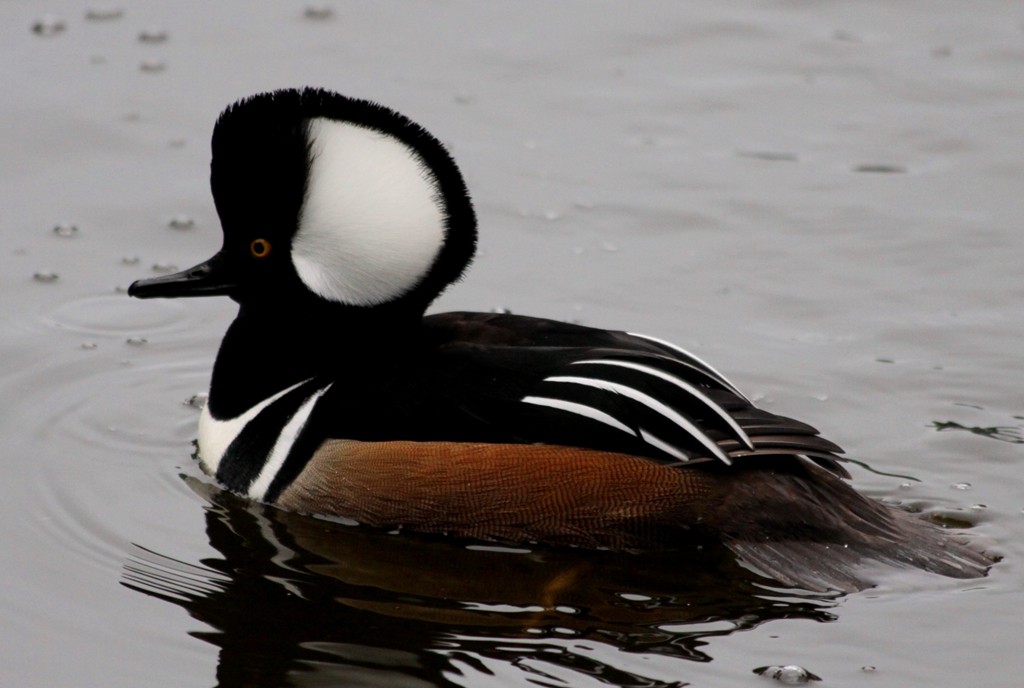
Hooded merganser(Mergus cucullatus)
Phylum —chordata
Class — aves
Order — anseriformes
Family — anatidae
Genus –mergus
Appearance
The hooded merganser is a sexually dimorphic species. The adult female has a greyish-brown body, with a narrow white patch over the lower breast and belly. She has a light reddish-brown crest extending from the back of the head. During the nonbreeding season the male looks similar to the female, except that his eyes are yellow and the female's eyes are brown.
In breeding plumage the dorsal areas and the head, neck and breast of the mature male are mainly black with white markings; there are large white patches on either side of the crest, and they are particularly conspicuous when he raises his crest during courtship. His lower flanks are a rich reddish-brown or chestnut in color, and the breast and undersides are more or less white, extending into white stripes across the crop and breast.
In both sexes there are narrow white stripes along the tertial wing feathers; when the bird is in repose they have the appearance of longitudinal white stripes along the bird's lower back, if they are visible.
Length – 15.8-19.3 in (40-49 cm); weight – 16.0-31.0 oz (453-879 g); wingspan – 23.6-26.0 in (60-66 cm).
Habitat
Hooded mergansers are short-distance migrants, and they winter in the United States in regions where winter temperatures allow for ice-free conditions on ponds, lakes and rivers. They have two major year-round ranges. One is in the eastern United States from the southern Canada–US border along the Atlantic Coast to the Gulf Coast in the region of the Mississippi delta. A smaller year-round range extends from Washington state and southern British Columbia to northern Idaho.
They also breed to some extent in regions from Missouri to southern Canada and from Nova Scotia to eastern North Dakota and Saskatchewan, migrating when necessary to avoid winter conditions.
Behavior
Although the hooded merganser is mostly aquatic and awkward on land, females lead their ducklings up to 1.2 km across land from inland nests in order to reach water. Hooded mergansers are clumsy, but quick, flyers. They take off by running on water, and they have a ceaseless and rapid wingbeat during flight. They land at high speeds and are often seen 'skiing' across the water to come to a stop. They dive well, holding their wings in close to their body and propelling themselves underwater with their feet. They have been seen gathering at roost sites in large groups during the nonbreeding season.
Diet
Hooded mergansers feed in clear aquatic habitats, such as forested ponds, rivers, streams, and flooded forests. Their primary foods include aquatic insects, fish, and crustaceans.
Reproduction
Males and females of the hooded merganser form monogamous pairs and they remain together until the female has selected a nesting cavity and completed laying her clutch. After that, the male leaves the female to incubate and care for the brood. Females will actively seek out cavities in dead trees or artificial nest boxes such as those provided for nesting wood ducks. They prefer cavities 4–15 feet off the ground. Breeding occurs anytime between the end of February and the end of June, depending on the region.
The female will lay a clutch of 7-15 eggs but only begins incubation when the last egg has been laid, thereby permitting synchronous hatching. All hatchlings are consequently of the same size, which facilitates efficient parental care. During incubation, the female may lose anywhere from 8% to 16% of her body weight.
Like most waterfowl, hooded merganser hatchlings are precocial and usually leave the nest within 24 hours after they hatch; this is about long enough to accommodate synchronous hatching. Once they leave the nest, the young are capable of diving and foraging, but remain with the female for warmth and protection.
Lifespan in the wild – 11years.
In captivity
Hooded mergansers are unpretentious. They can be fed with any feed. A good life condition for them is a reservoir in which they will find their own food not to bother their owners. In order for the ducks to grow strong and healthy at home, the chicks must be given pure cottage cheese and a mixture consisting of whey.
 Russian
Russian
 English
English
























